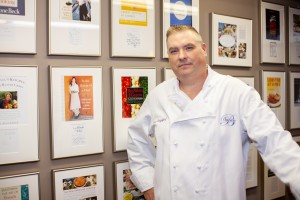 Chef Brian Kingsford of Bacaro got his start in the kitchen as a dishwasher at a breakfast restaurant when he was 12. Fairly quickly, he realized that dishwashing wasn’t his cup of tea and he wanted to be a line cook. At 14, he was given the opportunity to show what he was made of and he hasn’t looked back since. At 16, he moved on to Al Forno where he became a pasta and saucier cook under the guidance of George Germon and Johanne Killeen. After spending 17 years working alongside prominent chefs such as Wiley Dufresne and Suzanne Goin, Kingsford knew he was ready to start his own venture, Bacaro.
Chef Brian Kingsford of Bacaro got his start in the kitchen as a dishwasher at a breakfast restaurant when he was 12. Fairly quickly, he realized that dishwashing wasn’t his cup of tea and he wanted to be a line cook. At 14, he was given the opportunity to show what he was made of and he hasn’t looked back since. At 16, he moved on to Al Forno where he became a pasta and saucier cook under the guidance of George Germon and Johanne Killeen. After spending 17 years working alongside prominent chefs such as Wiley Dufresne and Suzanne Goin, Kingsford knew he was ready to start his own venture, Bacaro.
Gabby Halliday (Motif): Where does the name “Bacaro” come from?
Brian Kingsford: The name Bacaro comes from Venice where they refer to their wine bars as bàcari, named after the god of wine, Bacchus. They’re little wine bars that are known for tasting plates called chicetti. We had a bunch of ideas going back and forth when one day my wife calls me and says, “What do you think of the name Bàcari?” and I liked that, but I wanted to know if there was a singular version of that. After some research, we found out that it was Bacaro, and I knew that that was the name once we were able to trademark it.
GH: If you were an herb, which herb would you be? Why?
BK: I would have to go for versatility. I’d say mint. I think mint is a breath of fresh air in a lot of dishes, but it can be used across the entire spectrum of cooking. You can have it in pastries and desserts or you could have it in garde manger and in salads or entrees. I think of mint with lamb, mint with melons or mint with ice cream. Mint refreshes and brings brightness to a dish or it can overpower and be strong. It also describes my personality a bit because it seems delicate, but it’s anything but that. It likes to take charge.
GH: When you get a chance to eat out in Rhode Island, where do you tend to go most often?
BK: We don’t get to go out very often because we’re so busy. Even on the days that the restaurant is closed, there is still work to be done. However, when we do get to go out we love to go to Chez Pascal in PVD for their charcuterie or cassoulet and La Masseria in East Greenwich because they cook so authentically and we used to visit their location in New York.
GH: If it was your last weekend on Earth, what city are you visiting and what will you eat?
BK: The Taverna Trillusa in Rome is one of my favorites because it’s what our restaurant would be if we were in Italy in terms of their cuisine and approach. I can see myself sitting there with pasta, maybe amatriciana, and an array of aged prosciutto.
GH: Name one person, dead or alive, that you would love to cook with and why.
BK: I would love to cook with George Germon [former co-owner of Al Forno] again just to show him how far I’ve come and how great of an influence he was to me.
GH: Why did you choose this recipe?
BK: I was inspired to develop this recipe after I had an incredible veal Bolognese at Mario Batali’s Babbo in NYC. I use more tomato in my version than in the traditional Bolognese, but I feel that the acidity adds more balance to the dish, taming the richness and allowing one to consume more of this delicious pasta without feeling too overwhelmed. Although traditional, I do not use garlic in my sauce, which leaves the palate a bit cleaner in the end. I also like to soak the ground meat in the milk and heavy cream for a little while, allowing for the lactic acid to do its magic and offering a wonderful texture. This sauce is always better the next day, after the flavors have had time to come together. There will be plenty of sauce left over for lunch or a light pasta course with your next dinner.
Brian’s Veal Bolognese
Yield: 8 servings
1 lb ground pork
1 lb ground veal
1 cup heavy cream
1 cup milk
½ Tbs fennel seeds
1 can tomato paste
1 32 oz can of San Marzano whole peeled tomatoes in heavy puree
6 oz pancetta – medium dice
2 stalks celery, finely chopped in a food processor
4 carrots, finely chopped in a food processor
2 medium onions, minced
1 ½ cups dry white wine
¼ – ½ cup extra virgin olive oil
5 Tbs unsalted butter at room temperature
Salt and pepper to taste
Parmigiano-Reggiano for garnish
Parsley for garnish
2 lbs. tagliatell
Method:
Mix pork and veal with milk, heavy cream, fennel and a pinch of salt in a bowl and set aside while preparing the rest of the recipe.
In an 8 qt. heavy-bottomed sauce pan, heat ¼ cup of the olive oil over medium heat. Add the diced pancetta and sauté just long enough to render the fat, about 2 minutes. Remove the pancetta with a slotted spoon and set aside. Add the carrots, onion and celery to the hot oil with a pinch of salt, and sauté on a medium heat for about 10 minutes. Add the white wine and continue cooking until almost all of the wine has cooked out. Break the whole peeled San Marzano tomatoes up by hand, and place them back in the liquid they are packed with. Add the two meats along with the milk, fennel seed and the pancetta, San Marzano tomato and tomato paste and bring to a boil. Reduce to a simmer and allow to cook for about 1 ½- 2 hours. Season with kosher salt to taste. If the acidity has dropped to much during the long cooking, add a teaspoon of red wine vinegar. If the acidity is too high, add another pinch of salt to balance.
Bring 6-8 quarts of water to a boil. Once at a boil, season the water with kosher salt to taste, about 2 tablespoons.
Place about 5 cups of the Bolognese into a heavy bottom pan, and reserve the rest for another meal. Keep the sauce over a very low heat.
Boil the pasta short of the recommended cooking time on the package as they are usually incorrect. It is best to back off the recommended cooking time by 5 minutes and taste the pasta regularly after that until a texture a bit before al dente is achieved. Strain the pasta, reserving about a ½ cup of pasta water.
Place the strained pasta into the sauce along with the reserved pasta water and butter, and continue to cook the pasta on the stovetop until al dente — about one minute.
Garnish the pasta with freshly grated Parmigiano-Reggiano, fresh chopped parsley and a drizzle of fine virgin olive oil.


